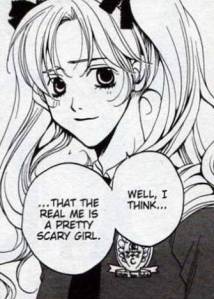Sean (A Case Suitable for Treatment) Gaffney is hosting the current Manga Moveable Feast, which is focusing on Setona Mizushiro’s After School Nightmare. Looking back on this column I wrote for The Comics Reporter, I realize I don’t really have anything to add, so I will lazily reprint the column here.
*
In a lot of manga aimed at an adolescent audience, the characters’ objectives are sunny and straightforward. Do your best! Be true to yourself! Learn! Grow! Befriend! Love! You can dress those objectives up however you like and contextualize them in sports or sorcery or pop stardom, but the bottom line is basically the pursuit of happiness.
What makes a book like Setona Mizushiro’s After School Nightmare (Go! Comi) so alluring is that it’s about the aversion of unhappiness. The objectives here are just as straightforward, but they’re bleaker and probably more honest. Keep your secrets. Hide your flaws. Try not to hurt anyone more than you can avoid, but a teen’s got to do what a teen’s got to do.
Mizushiro’s introduction to the English-reading audience came courtesy of Tokyopop in the form of the two-volume X-Day. It’s not a bad little book, but it suffers from inflated expectations. The synopsis promises a plot by moody loners to blow up their school, but the reality is much more subdued. It’s a dysfunctional character study, and it has its moments, but it ends up feeling like an old After School Special. Everyone learns a valuable lesson, which is rather disappointing.
But in X-Day, Mizushiro did demonstrate the will to go to dark places, and the book’s promise is fulfilled in After School Nightmare. Go! Comi tagged the ten-volume series with the line, “This dream draws blood!” It does, both figuratively and literally.
Mashiro Ichijo is an upstanding student. He works hard, he’s polite to his classmates, and he’s in the kendo club. He also has a vagina, but that’s a well-kept secret. It may not stay that way after Mashiro is enrolled in a special class by the school nurse. One day a week, Mashiro reports to the infirmary to drowse into a dream world where he must battle his classmates for a mysterious key that leads to an even more mysterious graduation.
Mashiro’s paranoid protectiveness of his public persona becomes heightened as he tries to determine which of his classmates are joining him on the subconscious battlefield. An aggressive kendo team-mate, Sou Mizuhashi, claims he knows Mashiro’s secret. Mashiro is simultaneously attracted and repulsed by what he perceives to be Sou’s uncomplicated masculinity, and Sou demonstrates a kind of unsentimental attraction for Mashiro in return.
Mashiro’s feelings for sweet, sunny Kureha Fujishima are no less complicated. He knows Kureha’s in the class, frozen in a traumatic moment from her childhood, and he wants to protect her. (It’s what a real man would do, after all.) Mashiro’s ambiguous gender allows Kureha to return his feelings; he’s not entirely male, so he’s not the object of terror she finds most men to be. But are Mashiro’s feelings sincere, or is he just role-playing, trying to meet ingrained expectations? That’s a question you could ask of any of the principle characters.
Mizushiro gets terrific mileage out of the question, spinning the love triangle over most of the ten-volume series. Mashiro, Kureha and Sou are all trying to reconcile their respective damage, and to varying degrees they do that by modulating to meet the expectations of others. But Mizushiro doesn’t romanticize that; secrecy and denial are the obstacles to the characters’ forward motion towards whatever graduation entails. They have to accept what they don’t like or what they fear about themselves. They have to stop caring how others see them.
It’s less her story than Mashiro and Sou’s, but I found Kureha mesmerizing from beginning to end. She represents a number of overly familiar character types — the pony-tailed princess, the unwitting beard, and the victim who’s never healed properly — but she doesn’t embody any of them. She’s too sturdy, surprising, and strange. And while Mashiro and Sou waffle and flail (entertainingly, I should add), Kureha evolves. And she does so without losing any of her radiance. If anything, she gains in radiance, especially in the dream sequences.
As to those subconscious throw-downs, do you remember those occasional sequences where the X-Men’s Danger Room would malfunction, plunging one or more mutants into a personally resonant horror? It’s like that, except every Thursday. Mizushiro is playing with allegories throughout the series, but she doesn’t shy away from brutality. After School Nightmare is one of the few shôjo series I’ve seen with sequences that could be scored with a Pat Benetar song.
Even with ten volumes at her disposal, Mizushiro finds room for so much. In addition to the emotional and metaphysical violence, there’s a lot of tenderness here. Not much sentiment, but that’s welcome. All she needs are three messed-up people trying to survive.





